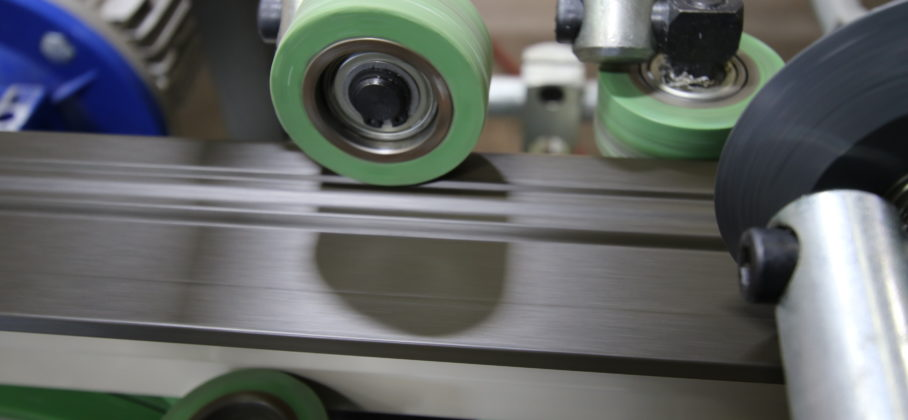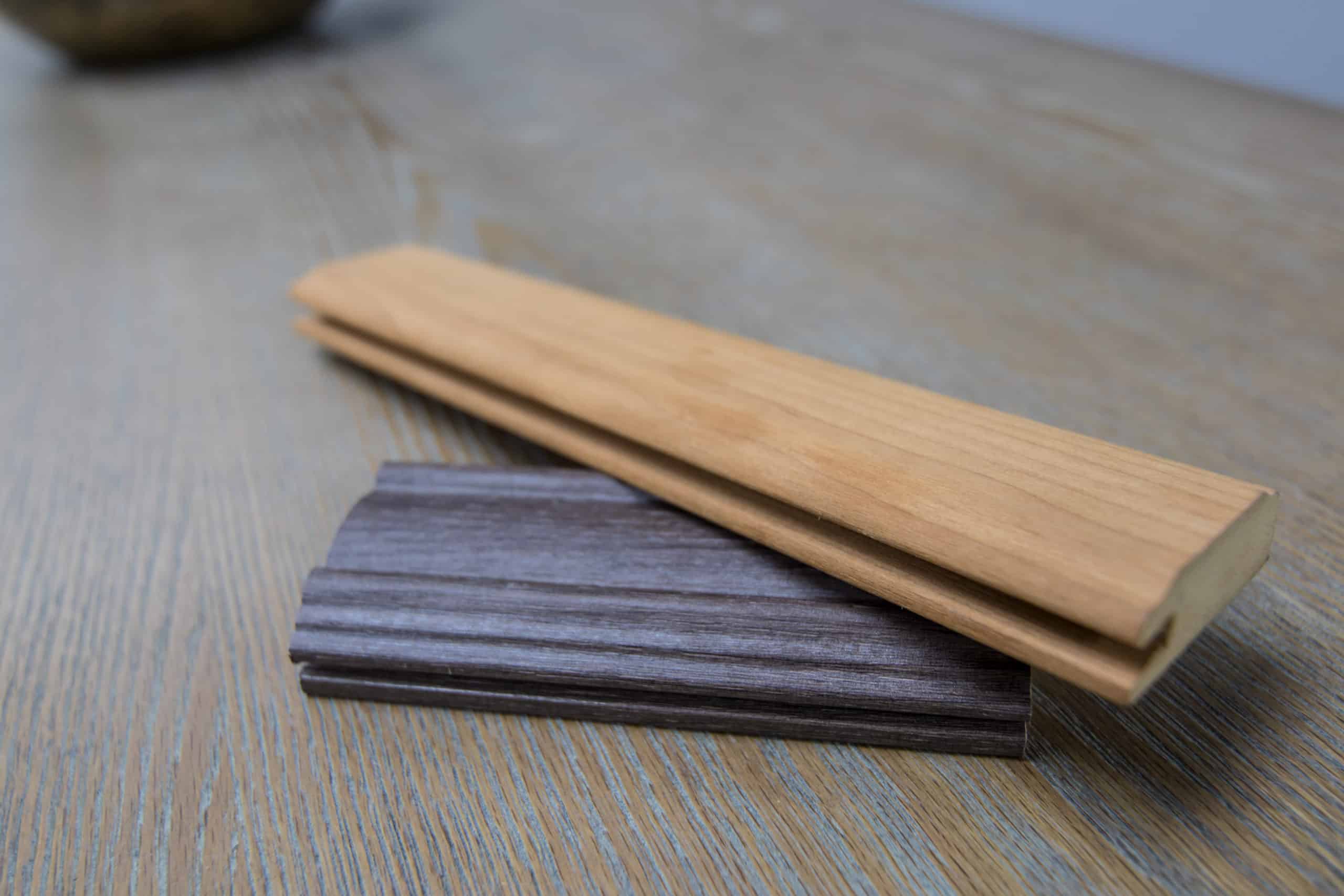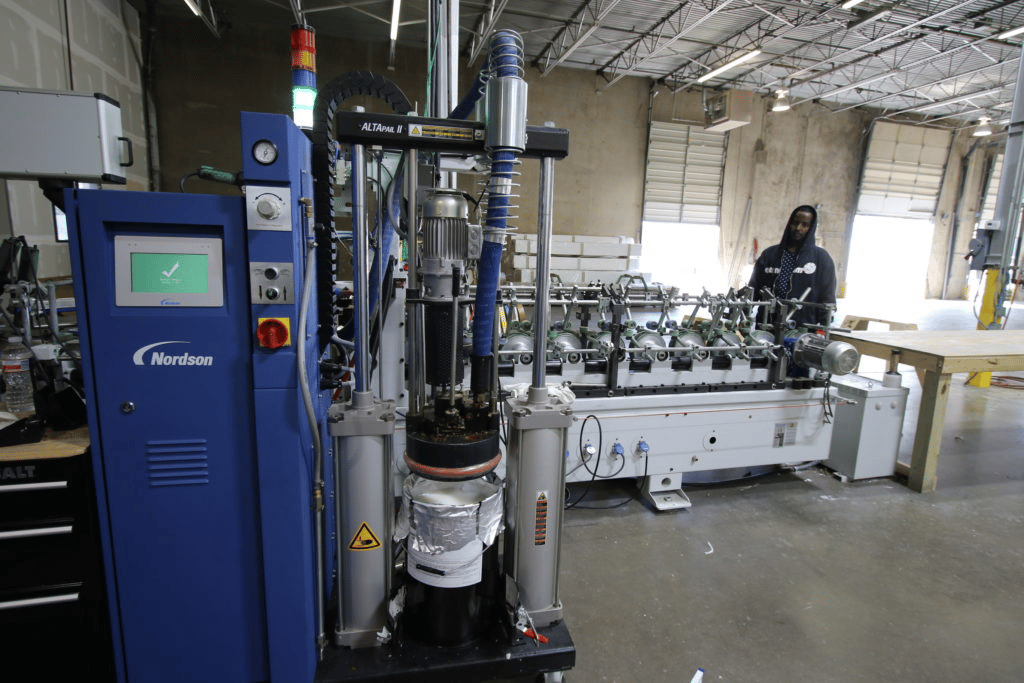Stealth Finishing specialize in applying acrylic/vinyl interior or exterior laminates as well as real wood veneers, paper veneer products, and paintable, stainable veneers to any profile aka “profile wrapping”. The profile or substrate can be made from any material that is consistent in size and shape. We offer a wide selection of interior and exterior decorative wrapping materials our customers can choose from.

For example, extruded PVC extrusions contain a substance, that will migrate to the surface of the substrate over time. Extruded PVC substrates will also pick up some lubricants that are used in the extrusion process. Because of the before mentioned reasons, the substrates should be primed anywhere the profile gets wrapped. The primer is applicated with felt pads cut to the precise dimensions of the profile wrapping area. In order to ensure a optimal adhesion and tension according to AAMA 303-12 all wrapped surfaces will need to be cleaned by this primer.
PLASTICS
• PVC (polyvinyl chloride)
• PP (polypropylene)
• ABS (acrylonitrile-butadiene-styrene)
• Expanded polystyrene
• and other
Substrates can erode after the wrapping process. The corrosion can destroy the glue layer, which leads to the fact, that the gluing and/or the overlay material becomes detached. To avoid peeling/corrosion, you can use a pre-treated metal for wrapping (painted, powder coated, chromed, …). Another solution, in case you work with raw and degreased metals, is the application of primer or the combination of a treatment in the plasma or corona method and primer.
METAL
• Aluminum
• Steel
• Others


SOLID WOOD
• Particle board
• Medium density fiber- board (MDF)
• High density fiberboard (HDF)
• Plywood
• and other
WOOD COMPOSITE MATERIALS
• “Extruded wood” (plastics+sawdust)
• Fiberglass pulltrusions


Interior films are used for window and door components and are not subject to full sun exposure. They are made of a different material that is meant for an indoor purpose only.

There are diverse types of vinyl films available. The most commonly used materials are hard / soft PVC and PP. Vinyl can be a solid color or have a printed pattern. Different topcoats are available for interior or exterior products.
The exterior films have to be durable against ultraviolet light. A special vinyl with a wood-similar surface (veneer characteristics) and aluminum similar surface (aluminum characteristics) is available for exterior application, which is mainly used by the vinyl window industry.
The newest development is a thermoplastic film for the decorative finishing of windows, doors and other building elements. This film is specifically designed for climatically difficult regions, because of the extreme weather and temperature instability. Under these difficult conditions the foil is continually tested and has retained outstanding color and gloss stability. Some of our exterior film providers even offer up to a 10-year warranty for these exterior films.


Laminates consists of decorative surface papers, which are impregnated with melamine resins and then pressed over Kraft paper core sheets impregnated with phenolic resin. These sheets are then bonded at pressures greater than 200 Kg per square cm at temperatures approaching 150 degrees Celsius. Finished sheets are trimmed, and the backs sanded to facilitate bonding. Laminates are more difficult to wrap in comparison with wrapping paper, because papers are more flexible. The variety of laminates ranges from high-pressure to low-pressure to continuous laminates. There is a difference in the way theses laminates are manufactured as well as in the flexibility of the material. Sharp edges are not recommended. For the flooring industry the laminates are coated with aluminum oxide.
The wood veneers are divided into two major groups: Rotary cut veneer and sliced veneer. Sliced veneer is the most common used veneer in profile wrapping. The complexity of the core material dictates the quality of veneer to be used.


Different paper types are available for profile wrapping. Paper for profile wrapping is usually constructed like a sandwich. It starts out with the base paper that is also referred to as the backer. The backer is available in assorted colors and different weights. The second item is a décor paper. The décor paper can be solid color or with a printed pattern. The décor paper is usually a 30 gram paper. This décor paper is laminated to the base paper. The color of the finished paper is dependent on the color of the base paper. These papers can range from 30 grams to 300 grams and more. Most commonly used papers are 60 or 80 gram papers. They can be wrapped around very complex profiles and at the same time they are not as fragile as a 30 gram paper. Paper can be wrapped around sharp edges (with exception of very heavy papers).
The decision, which adhesive should be used, depends on the profile substrate as well as the products end use.Substrates that are not made from derived timber products,plywood, wood or extruded wood (non-wood substrates) may require some treatment prior to wrapping. In any case the selected glue manufacturer should be consulted for a recommended treatment.

Today the most commonly used hot melt glues in the profile wrapping industry are categorized into NHR “Non-humidity-reactive” and HR “Humidity-Reactive”. The difference between “Non-humidity-reactive” and “Humidity-reactive” adhesive is, that humidity-reactive hot melt glue is received during the interlacing a chemical compound (isocyanates) with the humidity from the air. After the interlacing is finished crosslinking (3-5 days) it is impossible to re-activate and/or to liquefy the glue. The developed adhesive compounds are characterized to uphold under extreme temperature and weather resistance. For these reasons therefore, Stealth Finishing uses an Humidity-Reactive PUR hot melt glue.

PUR (Poly-Urethan-Reactive)
The abbreviation PUR stands for single component, humidity- reactive polyurethane hotmelts. The glue type PUR fulfills highest requirements regarding temperature-, water-, steam -, detergent- and solvent-resistance. The main advantages compared with EVA and PO are: High heat and water resistance. PUR adhesives are suitable for interior and exterior use without exception (all materials). PUR glue is offered in 5 gal pails (44lbs-55lbs) and 55 gal drum form . One producer offers PUR-granulate too. The glue in block form has a smaller surface compared with granulate, which reduce the danger of humidity interlacing. Due to the comparatively low working temperature PUR is most suitable for thin thermoplastic films.
To assure our window and door manufactures that they are receiving a consistent, reliable wrapped profile, our wrapping process is documented by: (Date, Time, Ambient Temperature, Relative Humidity, Film ID #, and Adhesive PUR glue batch #). Our in-house Laboratory tests, evaluate each profile for strength, and durability ensuring that our wrapping process meets our ambitious standards for all profile wrapped window and door components.
See the full AAMA 303-12 Specification by clicking here: link to the AAMA 303-12 page